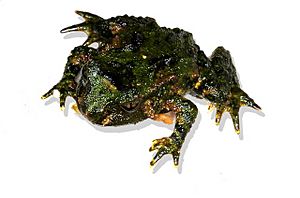Leiopelma facts for kids
Quick facts for kids Leiopelma |
|
|---|---|
 |
|
| Hochstetter's frog (Leiopelma hochstetteri) | |
| Scientific classification |
|
| Kingdom: | Animalia |
| Phylum: | Chordata |
| Class: | Amphibia |
| Order: | Anura |
| Suborder: | Archaeobatrachia |
| Family: | Leiopelmatidae Mivart, 1869 |
| Genus: | Leiopelma Fitzinger, 1861 |
| Species | |
|
See text |
|
 |
|
| Distribution of Leiopelmatidae (in black) | |
Leiopelma is a special group of frogs found only in New Zealand. They are often called New Zealand primitive frogs because they have some very old features. These frogs belong to a family called Leiopelmatidae, and Leiopelma is the only type of frog in this family.
Scientists believe these frogs have been around for a very long time. There are four types of Leiopelma frogs alive today. They are unique to New Zealand and are an important part of the country's wildlife.
Unique Features of New Zealand Frogs
New Zealand primitive frogs have some interesting features that make them stand out.
Special Bones and Muscles
These frogs have an extra bone in their back, called a vertebra. This means they have nine vertebrae in total, which is more than most other frogs. Adult frogs do not have tails. However, young frogs have small tail muscles. These muscles help them when they are very young, before their lungs are fully grown.
How They Jump and Land
When Leiopelma frogs jump, they land in a funny way. They often land on their bellies, like a "belly flop." After they land, they then move their legs into position for their next jump. Most other frogs can get ready for their next jump while still in the air. This unique landing style shows how ancient these frogs are.
Small Size and Long Lives
These frogs are quite small. They usually grow to be only about 5 centimeters (2 inches) long. Even though they are small, some Leiopelma frogs can live for a very long time. Some have been known to live for more than 30 years!
Life Cycle and Reproduction
Most Leiopelma species have a unique way of laying their eggs and raising their young.
Egg Laying and Tadpoles
Most New Zealand primitive frogs lay their eggs on moist ground. They often hide their eggs under rocks or plants. Unlike many other frogs, their tadpoles do not need to live in water. Instead, after the eggs hatch, the tiny tadpoles climb onto the male frog's back. They stay there as they grow, without needing a pond or stream.
However, one species, Hochstetter's frog, is a bit different. It lays its eggs in shallow ponds. Even these tadpoles do not swim far or eat much before they change into adult frogs.
Threats to New Zealand Frogs
Sadly, these special frogs face dangers from animals that have been brought to New Zealand by people.
Impact of Introduced Animals
Many animals, like ship rats, have been introduced to New Zealand. These animals hunt and eat the native frogs. In fact, most of the times these native frogs are attacked, it is by these introduced animals. This has had a very bad effect on the frog populations.
Species of New Zealand Primitive Frogs
Here are the different types of Leiopelma frogs, including those still alive and those that are now extinct.
Living Species
- Genus Leiopelma
- Archey's frog, Leiopelma archeyi
- Hamilton's frog, Leiopelma hamiltoni
- Hochstetter's frog, Leiopelma hochstetteri
- Maud Island frog, Leiopelma pakeka
Extinct Species
Scientists have found bones of three Leiopelma species that are no longer alive. These frogs became extinct in the last 1,000 years.
- †Aurora frog, Leiopelma auroraensis
- †Markham's frog, Leiopelma markhami
- †Waitomo frog, Leiopelma waitomoensis
Scientists have also found fossils of two other unnamed Leiopelma species. These fossils are much older, from a time called the Miocene epoch.
See also
 In Spanish: Leiopelmatidae para niños
In Spanish: Leiopelmatidae para niños

